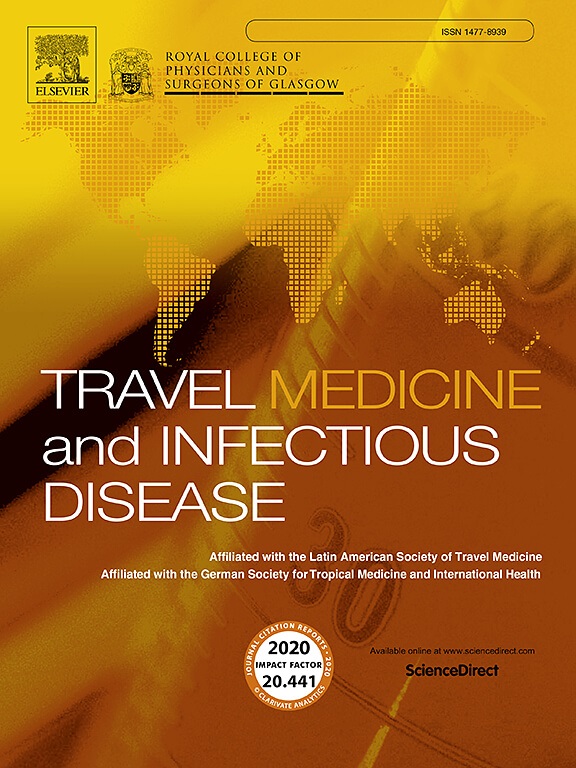急性暴露于高海拔时身体成分的变化与急性高原病有关。
IF 4.7
3区 医学
Q1 INFECTIOUS DISEASES
引用次数: 0
摘要
背景:急性缺氧暴露导致急性高山病(AMS)的高发和身体成分的改变,而身体成分与AMS的关系尚不清楚。我们设计了这项研究,以检测身体成分及其与AMS的关系。方法:将81名受试者从平原(300 m)转移到高原(3600 m),分别在平原和高原测量体重和体成分。采用路易斯湖评分(LLS)系统连续6天调查AMS的发生情况。进一步分析体成分与AMS之间的关系。结果:大鼠体重、无脂质量(FFM)、全身水分(TBW)、细胞内水分(ICW)、细胞外水分(ECW)和节段瘦肉质量随高原停留时间的延长而显著降低。与平原相比,高原的FM显著增加,矿物质在第3天显著增加,第6天显著减少。高原前6 d AMS日发病率分别为23.46%、7.41%、2.47%、2.47%、1.23%和2.47%。相关分析显示FFM、TBW、ECW的下降与LLS评分呈正相关。在AMS相关症状中,只有疲劳与FFM、TBW、ICW、ECW的下降呈正相关。结论:上坡初期机体成分发生了显著变化。FFM、TBW和ECW的下降可能与AMS的严重程度有关,疲劳与FFM、TBW、ICW和ECW的下降呈正相关。本文章由计算机程序翻译,如有差异,请以英文原文为准。
Changes in body composition during acute exposure to high altitude is related to acute mountain sickness
Background
Acute hypoxia exposure leads to a high incidence of acute mountain sickness (AMS) and changes in body composition, while the relationship between body composition and AMS remains unclear. We designed this study to detect the body composition and discern its relationship with AMS.
Methods
Eighty-one subjects were transported from the plain (300 m) to the plateau (3680 m). The body weight and body composition were measured in the plain and at the plateau. The occurrence of AMS was investigated by using the Lake Louise Scoring (LLS) system for six consecutive days. Then, the relationship between body composition and AMS was further analyzed.
Results
The body weight, fat-free mass (FFM), total body water (TBW), intracellular water (ICW), extracellular water (ECW) and segmental lean mass decreased significantly with the prolonged stay at the plateau. Compared with those in the plain, FM increased significantly at the plateau, and the mineral increased significantly on the third day while decreasing significantly on the sixth day. The daily incidence of AMS during the first 6 days at the plateau was 23.46 %, 7.41 %, 2.47 %, 2.47 %, 1.23 %, and 2.47 %, respectively. Correlation analysis showed that the decline of FFM, TBW, and ECW was positively correlated with the LLS score. Among the AMS relevant symptoms, only fatigue was positively correlated with the decline of FFM, TBW, ICW, and ECW.
Conclusions
Significant changes of body composition were observed in the early stage after ascent to plateau. The decline of FFM, TBW, and ECW might be related to the severity of AMS, and fatigue was positively correlated with the decline of FFM, TBW, ICW and ECW.
求助全文
通过发布文献求助,成功后即可免费获取论文全文。
去求助
来源期刊

Travel Medicine and Infectious Disease
PUBLIC, ENVIRONMENTAL & OCCUPATIONAL HEALTH-INFECTIOUS DISEASES
CiteScore
19.40
自引率
1.70%
发文量
211
审稿时长
49 days
期刊介绍:
Travel Medicine and Infectious Disease
Publication Scope:
Publishes original papers, reviews, and consensus papers
Primary theme: infectious disease in the context of travel medicine
Focus Areas:
Epidemiology and surveillance of travel-related illness
Prevention and treatment of travel-associated infections
Malaria prevention and treatment
Travellers' diarrhoea
Infections associated with mass gatherings
Migration-related infections
Vaccines and vaccine-preventable disease
Global policy/regulations for disease prevention and control
Practical clinical issues for travel and tropical medicine practitioners
Coverage:
Addresses areas of controversy and debate in travel medicine
Aims to inform guidelines and policy pertinent to travel medicine and the prevention of infectious disease
Publication Features:
Offers a fast peer-review process
Provides early online publication of accepted manuscripts
Aims to publish cutting-edge papers
 求助内容:
求助内容: 应助结果提醒方式:
应助结果提醒方式:


